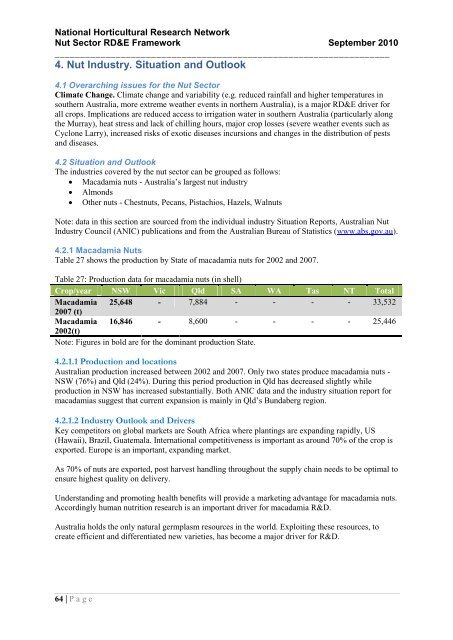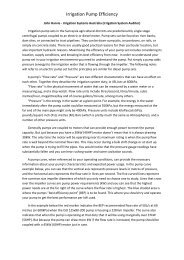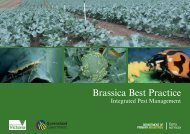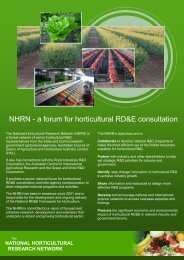National Horticultural Research Network - Horticulture Industry ...
National Horticultural Research Network - Horticulture Industry ...
National Horticultural Research Network - Horticulture Industry ...
You also want an ePaper? Increase the reach of your titles
YUMPU automatically turns print PDFs into web optimized ePapers that Google loves.
<strong>National</strong> <strong>Horticultural</strong> <strong>Research</strong> <strong>Network</strong><br />
Nut Sector RD&E Framework September 2010<br />
__________________________________________________________________<br />
4. Nut <strong>Industry</strong>. Situation and Outlook<br />
4.1 Overarching issues for the Nut Sector<br />
Climate Change. Climate change and variability (e.g. reduced rainfall and higher temperatures in<br />
southern Australia, more extreme weather events in northern Australia), is a major RD&E driver for<br />
all crops. Implications are reduced access to irrigation water in southern Australia (particularly along<br />
the Murray), heat stress and lack of chilling hours, major crop losses (severe weather events such as<br />
Cyclone Larry), increased risks of exotic diseases incursions and changes in the distribution of pests<br />
and diseases.<br />
4.2 Situation and Outlook<br />
The industries covered by the nut sector can be grouped as follows:<br />
Macadamia nuts - Australia‟s largest nut industry<br />
Almonds<br />
Other nuts - Chestnuts, Pecans, Pistachios, Hazels, Walnuts<br />
Note: data in this section are sourced from the individual industry Situation Reports, Australian Nut<br />
<strong>Industry</strong> Council (ANIC) publications and from the Australian Bureau of Statistics (www.abs.gov.au).<br />
4.2.1 Macadamia Nuts<br />
Table 27 shows the production by State of macadamia nuts for 2002 and 2007.<br />
Table 27: Production data for macadamia nuts (in shell)<br />
Crop/year NSW Vic Qld SA WA Tas NT Total<br />
Macadamia 25,648 - 7,884 - - - - 33,532<br />
2007 (t)<br />
Macadamia 16,846 - 8,600 - - - - 25,446<br />
2002(t)<br />
Note: Figures in bold are for the dominant production State.<br />
4.2.1.1 Production and locations<br />
Australian production increased between 2002 and 2007. Only two states produce macadamia nuts -<br />
NSW (76%) and Qld (24%). During this period production in Qld has decreased slightly while<br />
production in NSW has increased substantially. Both ANIC data and the industry situation report for<br />
macadamias suggest that current expansion is mainly in Qld‟s Bundaberg region.<br />
4.2.1.2 <strong>Industry</strong> Outlook and Drivers<br />
Key competitors on global markets are South Africa where plantings are expanding rapidly, US<br />
(Hawaii), Brazil, Guatemala. International competitiveness is important as around 70% of the crop is<br />
exported. Europe is an important, expanding market.<br />
As 70% of nuts are exported, post harvest handling throughout the supply chain needs to be optimal to<br />
ensure highest quality on delivery.<br />
Understanding and promoting health benefits will provide a marketing advantage for macadamia nuts.<br />
Accordingly human nutrition research is an important driver for macadamia R&D.<br />
Australia holds the only natural germplasm resources in the world. Exploiting these resources, to<br />
create efficient and differentiated new varieties, has become a major driver for R&D.<br />
64 | P a g e






